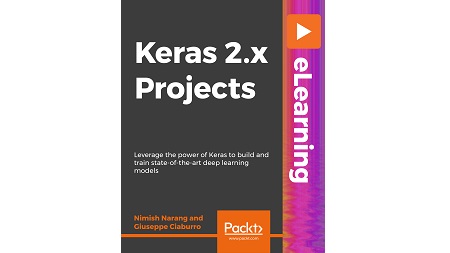
English | MP4 | AVC 1280×720 | AAC 44KHz 2ch | 5h 23m | 5.44 GB
Leverage the power of Keras to build and train state-of-the-art deep learning models
Keras is a Python library that provides a simple and clean way to create a range of deep learning models. This course introduces you to Keras and shows you how to create applications with maximum readability.
You take your first steps by getting introduced to Keras, its benefits, and its applications. As you get comfortable with Keras, you will learn how to predict business outcomes using time series data and various forecasting techniques. By learning the basic concepts of reinforcement learning, you will be able to create algorithms that can learn and adapt to environmental changes and control your robots. Then, you will learn various natural language processing techniques and use the Natural Language Toolkit to analyze, classify, and tag text.
By the end of the course, you’ll have the skills and the confidence to work on existing deep learning projects or create your own applications.
What You Will Learn
- Study in detail the process used to develop deep learning applications
- Discover how optical character recognition works
- Control the movements of a robot using Deep Q-Network (DQN)
- Explore and apply various reinforcement learning techniques
- Label sentences in the Reuters newswire with Keras deep neural network
- Analyze, understand, and generate texts using Natural Language Toolkit
Table of Contents
01 Course Overview
02 Installation and Setup
03 Lesson Overview
04 Introduction to Keras
05 Keras Backend Options
06 Model Fitting in Keras
07 The Keras Sequential Model Architecture
08 Keras Functional API Model Architecture
09 Lesson Summary
10 Lesson Overview
11 The Basics of Forecasting
12 Time Series Analysis
13 Time Series Models
14 Long Short-Term Memory (LSTM) in Keras
15 Implementing an LSTM to Forecast Stock Volatility
16 Data Scaling
17 Keras LSTM Model
18 Lesson Summary
19 Lesson Overview
20 Robot Control Overview
21 The Environment for Controlling Robot Mobility
22 Reinforcement Learning Basics
23 Keras DQNs
24 DQN to Control a Robot’s Mobility
25 The CartPole System
26 Q-learning Solution
27 Deep Q-learning Solution
28 Lesson Summary
29 Lesson Overview
30 Natural Language Processing
31 Sentiment Analysis
32 Natural Language Toolkit
33 Corpora
34 Word and Sentence Tokenize
35 Stemming
36 Implementing a DNN to Label Sentences
37 Data Preparation
38 Lesson Summary
Resolve the captcha to access the links!